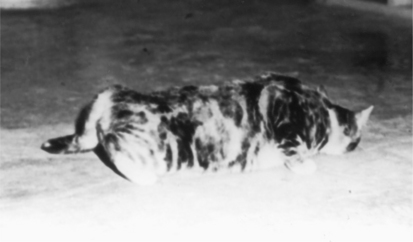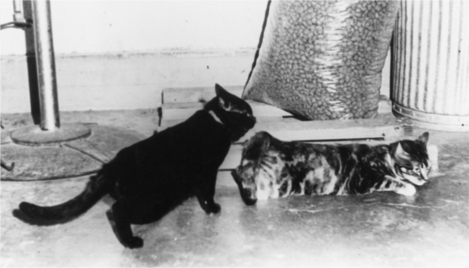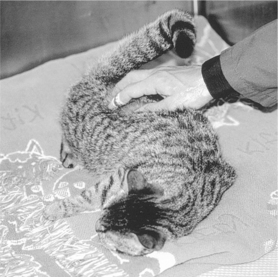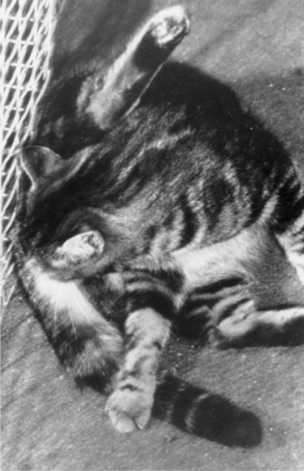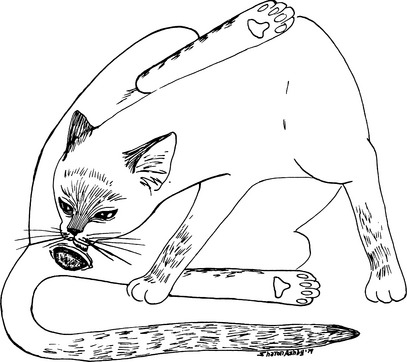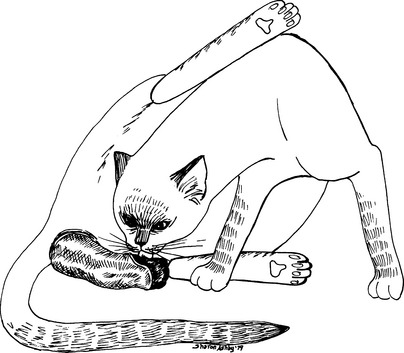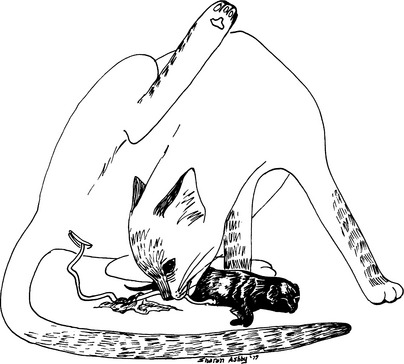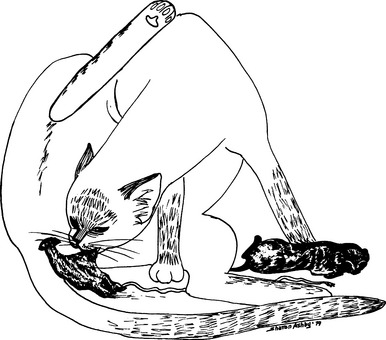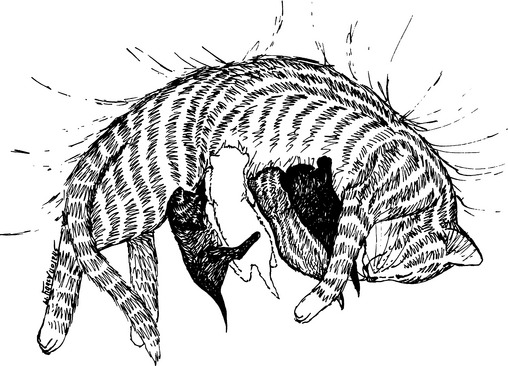Chapter 6 Female Feline Sexual Behavior
Throughout the years when cats have been closely associated with humans, selective breeding has accentuated certain color patterns and physical features. At the same time, codependent genes related to other features such as reproductive behavior and physiology can also be changed. This means variability is a common and normal feature in all phases of female sexual behavior of Felis catus, even among purebreds. Selective breeding for both domestication and breed development has tended to intensify feline sexuality and enhance the diversity of female sexual behaviors.
Sexual Maturation
The developing prenatal or early neonatal kitten that is not exposed to a testosterone surge develops the female nervous system, and at puberty the female behavior characteristics become apparent. The onset of puberty in the cat varies considerably, depending on several factors: The presence of a tomcat or estrous female, the time of year, and climate are more influential than age alone.62,83 For the tame domestic cat, the first signs of estrus appear between 3 and 12 months of age, usually at 5 to 9 months. (See Appendix D.) Burmese cats tend to be the youngest cycling breed, and Persian and free-ranging cats are apt to reach puberty at an older age, even as late as 15 to 18 months.30,58 Behavioral signs of the first estrus are usually associated with the physiologic ability to conceive.6
Reproductive Cycles
Seasonal Variations
The female cat is seasonally polyestrous and has several estrous cycles during each of its two or three seasons per year. In the latitudes of the United States and Europe, cats are generally anestrous from late September through late December or January and may show reduced sexual activity for a few months on either side of this period. Seasonal cycle peaks tend to occur between February and early April and between June and August, although they tend to be delayed in the northern latitudes and hastened in the south. A great deal of individual variation exists, and some cats, particularly short-haired varieties, cycle all year.13,53,58 At the other extreme, a wildcat may have only one seasonal cycle each year so that more time can be spent teaching skills to the young.5,13
The use of artificial light from September to March to lengthen “daylight” hours has been successful in many colonies to get females to cycle year round. Increasing the length of daily light from 12 to 14 hours will induce estrus in 44 to 45 days.83 If an additional 1 hour of exposure to light during the dark period is provided, estrus will occur in 15 to 16 days instead.83
Estrous Cycle
Anestrus
The anestrous female may rebuff an approaching tomcat by hissing and striking out. If she accepts the tomcat with relative indifference, she flexes her spine when he mounts and covers the perineum tightly with her tail, almost achieving a sitting position instead of the lordosis seen during estrus. The same behavior is exhibited by prepubertal kittens weighing more than 1500 g when mounted by a male. Kittens weighing less than 1000 g remain passive to the neck grip because it resembles the carrying grip used by the queen.81 The anestrous female also exhibits aggressive behaviors in attempting to free herself from an undesired mounting. Olfactory signals from her vulvar area apparently are repulsive to some tomcats, which will quickly turn away after smelling her perineum.81
Proestrus
The onset of estrous behavior may seem rather sudden to the owner because of a relatively short proestrous phase. Proestrus lasts between 1 and 3 days, and the associated behavior is highly variable among individuals. Only 16.1% of cats show proestrus.105 For these, it typically begins as a subtle increase in general activity and progresses to increased rubbing against objects, especially with the head and neck. This behavior may prompt owners to report that their cat has become friendlier. A tomcat’s approach no longer results in immediate sexual aggression by the female. The male cat’s neck grip and mount may initially cause the female to crouch partially and tread temporarily. His advances during proestrus eventually initiate her aggression. During this time owners may witness more aggressive interactions between the male and female than between tomcats.20 Amicable behaviors are also more often initiated by the female, and she is more likely to interact with a male that she knows.20 Her rubbing the chin and cheek on objects, including the tomcat, becomes very marked within 36 hours of the onset of proestrus, and when done to a person, it may be related to courtship rather than marking.24 Rubbing progresses to rolling, either gentle or violent, which is usually associated with purring, rhythmic opening and closing of the claws, squirming, and stretching81,111 (Figure 6-1). Catnip may evoke a somewhat similar behavior.
The female begins calling to a male using the “heat cry,” a vocalization unique to proestrus and estrus. This sound is a monotone howling that lasts up to 3 minutes at one time. Approximately 12% of the females eventually call continuously, although this behavior is more prevalent in Siamese females. Another 14% vary considerably in the frequency of the call.58 Some estrous females apparently do not call at all.20 This cry is mimicked by the tomcat, answered by the female, and again mimicked by the male. The female may spray urine,8 so that both the urine and the sebaceous secretions left by rubbing serve to attract males, particularly in areas where cats live relatively close together.24,116
Estrus
As the female enters estrus, a dramatic change occurs in her behavior toward the male. She still rolls and rubs, but no longer does she aggressively refuse the male’s attempts to mount, exhibiting a crouching lordosis instead. In this position the ventral thorax and abdomen touch the floor, and the perineum is elevated because the hindlimbs are positioned caudal to the body and extended perpendicular to the ground (Figure 6-2). This copulatory stance can be induced by stroking the queen’s back, thighs, or neck. Her tail is laterally displaced, and there may be a small amount of sanguineous discharge on the vulva.111
The behavioral events of mating begin with appetitive sexual behavior, or courtship. The elaborate courtship behaviors are important to bring males and females together. To ensure that males will be available and can succeed in intermale competition (although the winner may not be the one she eventually chooses) the female starts advertising before she is fully receptive. This courtship period also helps give the greatest number of healthy males an equal chance at reproduction.70 The female usually sits some distance away from the competition. She may show preference or dislike for an interested male. This choice probably has an olfactory basis, because changes in the nasal mucosa occur in association with the estrous cycle.84 Evidence indicates that odors affect reproduction in several mammals by means of the nervous and endocrine systems, and theories to the contrary fail to take the learning process into account.84,114
Lordosis is necessary if intromission is to occur and can be stimulated by the treading of the mounted male. While the male performs copulatory thrusts, the female adjusts her position slightly by alternate treading with her hindlimbs. During estrus, this rhythmic step, tail deviation, and rolling can be initiated by gently petting or tapping the female’s perineum, flank, or back (Figure 6-3). The facial expression associated with mating is often intense, similar to that seen in aggressive cats and some that are fearful. In addition, the ears are positioned rostrolaterally. The crouching, rubbing, rolling, and treading portions of courtship last between 10 seconds and 5 minutes, tending to be shorter with repeated breedings.5,31
Postmating behavior of the female is characteristically dramatic. As the male starts to withdraw his penis after ejaculation, the female’s pupils suddenly dilate. Immediately after, 53.8% of queens will utter the copulatory cry, a shrill piercing vocalization.96 Then 76.9% of queens will turn aggressively on the male.96 To a familiar male, the female may be less aggressive and might instead proceed directly into the “afterreaction.” During the afterreaction, the consummatory portion of the female’s sexual behavior, she again rolls on the floor, stretches, and licks her vulva (Figure 6-4). This period lasts from 1 to 7 minutes.68
Typical estrous mating behavior resumes in 11 to 95 minutes (mean 19 minutes). Experienced pairs may mate as frequently as 8 times in 20 minutes, or 10 times per hour.5,30,31 Female cats have been known to mate more than 50 times during an estrous period.51 As mating continues over the next few days, the refractory period (the time between these behaviors) becomes longer. The female mating interval, however, actually decreases, and she becomes more active in encouraging the male to mount. This is particularly true of naive females.122 Thus the male is primarily responsible for the increased time lapse between breedings. An estrous female can be conditioned to assume the estrous posture whenever she is placed in the mating area, even in the absence of a male.81,122
A mutual attraction between tomcat and queen can last for extended periods. A female will generally accept a number of males during her estrous period, and many litters have multiple sires.24,26,30 If there is a central tomcat, he is the primary breeder of that female group, even with other peripheral males courting the females.72 This is because of his proximity to the queens. He is not likely to fight off other males though, because it would be too dangerous for any one male to attempt to keep them all away.85 When females are in the proximity of related males, they are more likely to leave their home areas during estrus than are those without related males nearby.73
The cat is an induced ovulator, so an estrous female generally does not ovulate unless mating occurs. Ovulation occurs approximately 24 hours after copulation—the same amount of time needed for sperm to capacitate.85 The ovulation is probably induced by vaginal stimulation from the male’s penile spines or by artificial means, such as with a glass rod. More than one natural mating may be necessary for conception.104 Artificial stimulation requires several insertions of approximately 10 seconds in duration, 5 to 10 minutes apart, over a 48-hour period. Successful stimulation by either method causes the typical postcopulation aggression. The number of ovulation sites on the ovary varies directly with the number of matings and can include as many as 86.6% of the follicles with repeated matings.124 All eggs leave the ovary at the same time.26
Ovulation has been prevented by a systemic shock factor such as abdominal surgeries but only if the shock occurs within 55 minutes after mating.2
The female remains in estrus for 2.5 to 11.1 days (range 2 to 19 days), a period that may include proestrus and metestrus.96,105 She is most receptive on the third and fourth days if mated during that time. Estrus ends rather abruptly, within 24 hours after coitus. If pregnant, the cat usually will not return to estrus again until the next seasonal peak or the next year. However, about 10% of the pregnant queens display estrous behavior and produce a vaginal smear typical of estrus during the third to sixth week of gestation, possibly because of estrogen secretion by the placenta.3,102,109 Mating at this time can result in superfetation.57,109 Nursing queens have also been known to exhibit estrus 7 to 10 days after parturition, but estrus generally does not occur during lactation, so most do not return to estrus until 6 to 8 weeks after giving birth. It can be delayed as long as 21 weeks.58,102 Postpartum estrus has a shorter duration than the initial estrus, averaging 3.8 days.99
When no tomcat is present, the female remains in estrus for 10 to 14 days, although the first estrus might last only 5 to 10 days.51 She returns to estrus in 9.0±7.6 days (range 5 to 22 days).105 Some studies suggest a minimal difference between bred and open estrus duration.96,105 The average estrous cycle is 21 to 29 days long, but it can vary from 5 to 73 days. Young females tend to exhibit minimal estrous signs; become hyperexcitable, anorectic, or withdrawn; and have a shorter estrous period. In contrast, older females continue to cycle, even though the interval between estrous periods might increase and duration and intensity of estrous behavior decrease. Approximately 35% of the time, ovulation will occur without coitus.66 In such a cat or in one that mated but did not conceive, the luteal phase will last 30 to 36 days and the interestrous interval is 35 to 76 days.96,105,124
Because some of the environmental factors that affect the onset of puberty in the female can also affect the onset of estrus, the nonpregnant female has been described as being in “potential” estrus during the mating season.30,31 The result of exposure to certain factors, such as a tomcat or other cycling females, is the appearance of proestrus and estrus within a few hours to 3 or 4 days and a synchronization with female groups.22,72,73 Valeric acid is plentiful in vaginal secretions during estrus and may be associated with the synchronization.11 Other factors, such as a colony relocation, can result in coordinating estrous cycles for 42% to 77% of the females.123
Estrous behavior has been controlled with vasectomized male cats. In females mated to such tomcats, estrus lasts approximately 7 days and is followed by a 36- to 44-day interestrous period of pseudopregnancy.31,69,86,93
The behavior of a female cat, her vaginal smear, and her phase in the reproductive cycle are very closely correlated. Of the cats exhibiting estrous behavior in one study, 78% had a fully cornified estrous vaginal smear and another 18% were in proestrus.81
Metestrus
The behavior of metestrus begins with the appearance of leukocytes in the vaginal smear.80 This phase rarely lasts more than 24 hours and is generally included in time ranges given for estrus because all of the postural responses continue and mounting is allowed. The female aggressively rejects the male during this phase only when he attempts intromission.
Interspecies Matings
Periodically, newspapers carry articles about the offspring of cats that have mated with other animals, but they are generally not substantiated. A reported cat-rabbit cross that hopped around one town was really a tailless Manx cat with spinal cord problems. F. catus has 38 diploid chromosomes, as do most of the large cats of the Felidae family.25,121 Ocelots are the noted exception, with 36 chromosome pairs. Crosses of domestic cats with larger cats having 38 chromosome pairs have been reported, but the fertility of the offspring is variable.36
Pregnancy
In a laboratory setting, the pregnancy rate is 73.9% of bred queens, but because of reabsorptions, the queening rate is somewhat lower (65.2%).96 In general then, the uncontrolled female cat is always pregnant, nursing, or both, except possibly in the late fall, and her entire body is geared for these conditions. In a home environment where the female is not allowed to breed, she is probably healthier physiologically and psychologically if ovariohysterectomized.
Gestation
The duration of gestation in the cat ranges from 60 to 68 days, with an average of 65 to 66 days. Gestation periods of 52 to 71 days have been reported; however, births before 60 days should be regarded as premature because they are often accompanied by a higher than normal rate of stillbirths and early postnatal deaths.90,104
In the week immediately preceding parturition, the queen will seek a dark, dry area where she can remain relatively undisturbed. Ideally, this place will also contain shelter from the elements and a soft bedding material. A queen can choose a single, hidden nest site, or if she is associated with a group, she may share a communal nest.76 Site selection may relate to the degree of cover available or the proximity to food sources for the queen or her older kittens. Perhaps it may even be chosen for the possible social interactions.27 This early selection of the nesting area allows for the time required for the site to take on the female’s odor so that she can relax in a familiar environment. This is somewhat similar to the function of sprayed urine in the tomcat’s environment. The amount of seclusion preferred by a female during parturition is highly individual. Some actually seek out human companionship at this time and may finally choose the owner’s bed as the queening area. Most prefer seclusion and would find the hayloft of a barn more acceptable. Queens living with several other related and unrelated females may use a communal nest.19,22,27,52 During the last week the queen drives off kittens from the previous litter that are still with her. After queening, however, she may accept them back to nurse with her new offspring. During this period before delivery, the queen usually spends an increasing amount of time in self-grooming, particularly of her mammary and perineal areas, perhaps because of the increased cutaneous sensitivity in those regions.5,24,100 Her personality may also become more irritable or defensive.
As parturition becomes imminent, the female becomes increasingly restless, digs at the floor or nesting material, and assumes a defecation posture without defecating. There may be calling vocalizations, particularly by Siamese cats, and a few queens become excessively anxious, almost frantic.30
Parturition
Most births occur at night, often in isolated locations, so parturition is not always observed. Because the cat is multiparous, the four phases normally associated with parturition are repeated several times. The termination of a kitten’s birth occurs at the onset of contractions for the next. With multiparous animals, the delivery of a placenta does not necessarily mark the termination of parturition. The total time for normal parturition ranges from 4 to 42 hours (16.1±14.3 hours is average).96
Contraction phase
During the first phase, contraction, the queen spends a great deal of time licking herself or the newborns already delivered. The abdominal musculature shows obvious contractions, which are considered to accompany uterine contractions. Pelvic limb movements by the queen should help distinguish these abdominal contractions from fetal movements.100 Other signs of restlessness are obvious. In addition to squatting and scratching, the queen may circle, rearrange bedding, roll, or rub. She generally appears uncomfortable and seems to be constantly trying to adjust for some disturbance at the caudal portion of her body, even bracing her body against various objects. The duration of the contraction phase is variable, ranging from 12 seconds to 1½ hours.18,100
Emergence phase
During the emergence phase, uterine contractions cause the kitten to pass through the birth canal and pause in the vulva (Figure 6-5). Usually the amniotic sac has been broken by uterine contractions, but if not, the queen’s licking soon breaks it. The release of fluids from the amniotic sac causes the queen to spend additional time licking the fluids and coincidentally herself and the newborn.43,53,100 Experienced queens may direct more attention to the newborn, but other behaviors are quite similar to those of the contraction phase.
Delivery phase
The third phase, delivery, represents passage of the fetus from the vulva100 (Figure 6-6). Licking directed specifically at the newborn increases, although the queen may not begin immediately after the delivery. This licking supplies the stimulus for initiation of the newborn’s respiration if passage through the birth canal did not. A first-litter queen tends to be the most restless and is less likely to lick herself and each kitten correctly.22 Experience apparently is needed to refine these behaviors. From lateral recumbency the queen may try to reposition herself after the delivery and may coincidentally drag the kitten around by the still-attached umbilical cord, perhaps even stepping or sitting on it. Distress cries from this newborn or others are often ignored by the queen at this time, perhaps because of the excitement associated with parturition, or incomprehension of the vocal cue, or both.22,100 Kittens can be injured during this period. Shortly after parturition, generally 1 to 4 minutes later, the female becomes responsive to the kittens.18,100 She will sever the umbilical cord shortly after the delivery in about one third of the births (Figure 6-7).
There is tremendous variation in the intervals between kitten births, ranging normally from 32 seconds to more than 50 minutes.53,100 Most kittens are born within 15 to 30 minutes of each other, with a total delivery time of 1 to 2 hours.13,14 Some normal queens will take as much as 33 hours to complete the deliveries, but usually external disturbances, such as the absence of an owner or the moving of a nesting area, cause this extreme delay. Uterine inertia is relatively rare in cats.61 There is no relationship between the sequence of a kitten’s birth and the interval between its birth and that of its littermates.
Placental phase
The last of the four phases of parturition, as they usually occur, is the placental phase. During this time the placenta is expelled from the genital tract. Immediately before this expulsion, the female becomes restless, again appearing to focus her attention toward the caudal part of her body. She responds promptly to the emergence of this tissue, sometimes eating it before it has completely emerged100 (Figure 6-8). No relationship has been shown between the sequence of the births and either the interval of response to the placentas or the rate and completeness of its consumption.100 At times, a second or even third kitten is born before the umbilical cord of the first is severed or the placenta passed, but each will be attended to as time permits. Nutritive value from the afterbirth is considerable and allows the queen to spend more time with her offspring for the first few days than if she had to seek food as usual. In addition, this behavior minimizes the soiling of the nest area. The queen continues genital and neonatal licking during the placental phase but takes time to sever the umbilical cord with her carnassial teeth. Their crushing action, the stretching of the vessels, or both prevent fatal umbilical hemorrhage.40,100 The queen’s care during this phase makes cannibalism as a consequence of overzealous eating of the placenta and cord very rare.
For those queens sharing a communal nest, one may be assisted immediately postpartum by another female.19 The help usually is to clean and dry the young, but it can include severing the umbilical cord.22
Litter Size
The number of kittens born to a queen varies considerably, usually ranging between one and nine. Record litters of 13 kittens and one unusual incidence of a queen carrying 18 fetuses have been reported.9,125 Of the kittens born alive, between 72% and 87% will be successfully raised to weaning.58,89,96,101 Three to five then is an average litter, even for artificially induced pregnancies, and the male/female ratio of these kittens varies from 1:1 to 4:3. Although 7% of the older queens will litter three times a year, the mean is 2 litters.73,95 Most litters result from several matings on consecutive days. Even though this increases the number of ovulation sites, litter size is not affected by the number of days the queen mates.90 A queen then will normally bear between 50 and 150 kittens in a breeding life of about 10 years if allowed to mate naturally.127 Some may produce for 13 or more years, but peak productivity is generally between the ages of 2 and 8 years.5,60 One cat is known to have produced 420 kittens in 17 years, and another is said to have been pregnant at 26 years of age.17,125 At 8 kittens per year per generation, a queen could ultimately be responsible for 174,760 cats in 7 years.12
Normal birth weight varies between 80 to 120 g, averaging about 113 g.35,47,59 Also, the total birth weight relative to the queen’s weight is significantly greater for kittens born to smaller queens compared with that of kittens born to larger females. This is despite the fact that larger queens tend to produce a larger number of kittens in each litter.35
In cats, abortion and stillbirths are common; one or two often occur per litter.58,101 The incidence is 4.7% stillbirths.96 These events may be difficult to observe, because the queen normally eats these fetuses. The stillborn rate is higher in older queens; in overweight cats; and in the Persian, Maine coon, Himalayan, and Manx breeds.59,75,89,90,101 Other losses are associated with queens having nest sites away from the center of a farm.63 This may be due to the queen not having others to help guard the nest site, increased vulnerability of the nest, and/or greater likelihood of disease. Some peripheral queens may not have any descendants, even over a 7-year span.63
Maternal Behavior
Mother-Young Interactions
The primary social pattern exhibited by the female cat is maternal behavior. In general, this behavior involves exaggerated licking of self and young, as well as the care of the young.100 For the first few days after the completion of parturition, the queen remains almost continuously with the kittens, seldom leaving for more than 2 hours at a time, and then mainly to eat and exercise. During these early days, the kittens are particularly dependent on their mother for her warmth. A little while later they are able to maintain body temperatures in the warmth of the kitten huddles.32 Much of the queen’s time during the first few days is spent nursing the offspring, although the kittens may not nurse for as long as 2 hours postpartum. For nursing, the queen “presents,” assuming lateral recumbency with her limbs and body completely enclosing the kittens (Figure 6-9). She may even twist her body to expose more of the mammary region. To stimulate the young to begin nursing, the female licks and often awakens them. Initially the direction of licking helps orient the blind kittens to her mammary region, but later, licking is concentrated on the kitten’s anogenital region to stimulate eliminations. The queen’s ingestion of this waste also helps keep the home area unsoiled. Once the queen presents the mammae, the entire litter usually nurses, but occasionally it may be only one or two individuals. During the first week, about 90% of the female’s time is spent with her kittens, and as much as 70% is spent nursing them. By the fifth week, her time with the kittens decreases to 16%.92,100 Initially each kitten spends about 25% of its time nursing, which decreases to about 20% by the fifth week.64 Kittens spend almost all their time in contact with each other or the queen for the first 3 weeks, and contact time only decreases to 85% over the next few weeks.92
Stay updated, free articles. Join our Telegram channel

Full access? Get Clinical Tree


